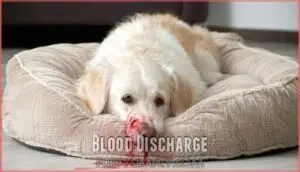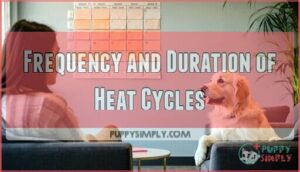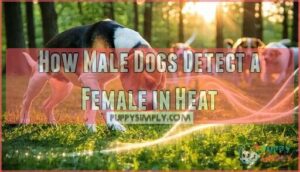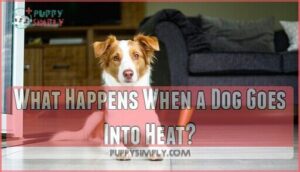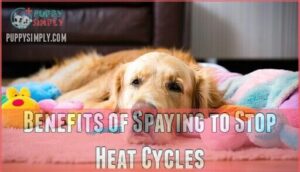This site is supported by our readers. We may earn a commission, at no cost to you, if you purchase through links.
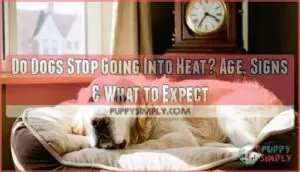 Your female dog won’t stop going into heat naturally – she’ll continue cycling throughout her entire life unless you spay her or she develops a medical condition.
Your female dog won’t stop going into heat naturally – she’ll continue cycling throughout her entire life unless you spay her or she develops a medical condition.
Unlike humans, dogs don’t experience menopause. However, as your furry friend ages, her heat cycles might become less predictable, occurring every 8-12 months instead of the typical 6-month schedule.
The cycles may also become lighter or shorter. Think of it like an aging clock that still ticks but runs a bit differently.
While senior dogs can still get pregnant, fertility often decreases with age, making conception less likely but not impossible. Understanding these changes helps you better manage your dog’s reproductive health throughout her golden years.
Table Of Contents
- Key Takeaways
- What is a Dog’s Heat Cycle?
- Signs and Symptoms of a Dog in Heat
- Frequency and Duration of Heat Cycles
- Age at Which Dogs Stop Having Heat Cycles
- Can a 10-Year-Old Dog Still Have Heat Cycles?
- Understanding The Phases of a Dog’s Heat Cycle
- How Male Dogs Detect a Female in Heat
- What Happens When a Dog Goes Into Heat?
- Benefits of Spaying to Stop Heat Cycles
- Irregular or Missed Heat Cycles: When to Consult a Vet
- Frequently Asked Questions (FAQs)
- What happens if a dog stops going into heat?
- When does a dog go into heat?
- How long does heat last in dogs?
- When does a female dog stop going into heat?
- Will my dog ever go into heat again?
- What happens if a female dog is in heat?
- How long are dogs in heat?
- How often do dogs go into heat?
- What are common behaviors of a female dog in heat?
- Do dogs have periods?
- Conclusion
Key Takeaways
- Your female dog won’t stop going into heat naturally unless she’s spayed or has a medical condition.
- Dogs don’t experience menopause, so they’ll continue cycling throughout their lives, though cycles may become irregular with age.
- Older dogs can still get pregnant, but fertility decreases, and risks like pyometra increase.
- Spaying eliminates heat cycles, prevents reproductive health issues, and offers long-term health benefits.
What is a Dog’s Heat Cycle?
Understanding your female dog’s heat cycle is like having a roadmap to her reproductive health.
The dog heat cycle represents your pet’s fertile window when pregnancy becomes possible.
This natural process involves significant hormonal changes that affect her reproductive anatomy and behavior.
Female dog heat typically begins between 6-24 months, with smaller breeds starting earlier than larger ones.
The heat cycle length averages three weeks, divided into distinct cycle stages.
During proestrus, you’ll notice initial signs of heat including vulvar swelling and bloody discharge.
The estrus phase follows, marking peak fertility when mating occurs.
Heat cycle symptoms include increased urination, behavioral shifts, and male attention.
Most dogs experience this cycle every six months throughout their lives unless spayed.
Unlike humans, dogs don’t reach menopause, so unspayed females continue cycling well into their senior years, making understanding these patterns essential for responsible pet ownership.
Signs and Symptoms of a Dog in Heat
You’ll notice several clear physical and behavioral changes when your female dog enters her heat cycle, making it easy to identify this natural reproductive phase.
These signs typically include a swollen vulva, bloody discharge, increased urination, and noticeable shifts in your dog’s behavior around other dogs, which are all key indicators of this phase.
Increased Urination
When your female dog enters her heat cycle, you’ll notice her making more frequent trips outside due to increased urination.
This isn’t just about bladder control – it’s nature’s way of spreading her scent to attract potential mates. The hormonal surge during this reproductive phase causes her to urinate more often than usual.
Here’s what drives this urination frequency:
- Scent marking becomes her primary communication tool with male dogs
- Marking behavior intensifies as hormones peak during heat
- Dog reproductive health changes trigger bladder sensitivity
Watch for signs of urinary infections, which can occur during this vulnerable time in your female dog’s heat cycle. During this time, managing potential messes may become necessary.
Blood Discharge
When your dog enters heat, you’ll notice bloody vaginal discharge that’s typically bright red initially, then changes to a lighter pink or straw color.
The discharge volume varies by dog size, and consistency ranges from watery to thick.
Clean the area gently with warm water and watch for unusual odors or excessive bleeding, which could signal infection requiring veterinary attention.
Many owners seek products managing discharge during this time, looking for ways to manage discharge and ensure their dog’s health, which may involve addressing potential veterinary issues.
Swollen Vulva
One of the most obvious signs of heat is when your dog’s vulva becomes noticeably enlarged and puffy.
This vulva swelling typically begins during the proestrus phase and can double or triple in size compared to normal. The swelling causes discomfort, leading to increased licking behavior as your pup tries to soothe the area.
Watch for these key vulva size changes during your dog’s heat cycle:
- Gradual enlargement – The vulva slowly becomes more prominent over several days
- Color changes – Shifts from pink to deeper red or purple hues
- Firm texture – The area feels harder and more swollen to touch
- Discharge appearance – Clear or bloody fluid may be present around the vulva
- Infection signs – Unusual odor, excessive discharge, or extreme swelling requires immediate vet attention
These dog heat symptoms help confirm your pup’s reproductive cycle has begun.
Behavioral Changes
Beyond the physical signs like a swollen vulva, your dog’s personality might seem like it’s been flipped upside down during heat.
She’ll display a cocktail of confusing behaviors that can leave you scratching your head.
Altered Affection becomes obvious as she alternates between clingy cuddles and standoffish moments.
Roaming Tendencies kick in, making her wander further than usual during walks.
Social Interaction patterns shift dramatically – she might ignore her favorite canine buddies or become unexpectedly aggressive.
| Behavior Change | What You’ll Notice |
|---|---|
| Grooming Changes | Excessive licking of back end |
| Appetite Changes | Eating less or refusing meals |
| Restlessness | Pacing, difficulty settling down |
| Attention-seeking | Following you everywhere |
| Nesting behavior | Gathering blankets, toys |
These dog behavior changes are completely normal responses to hormonal surges during her heat cycle.
Receptiveness to Males
When your dog’s fertile window opens, you’ll notice dramatic changes in her mating behavior.
She’ll position herself differently around males, flagging her tail to one side and standing still when approached. This male attraction peaks during estrus, though she may show rejection signs early in heat cycles.
Her mate selection instincts kick in strongly, making supervision essential for preventing unwanted canine fertility situations.
Male dogs will exhibit heightened interest in mating due to the female’s pheromones.
Frequency and Duration of Heat Cycles
You can expect your dog’s heat cycles to occur roughly every six months, lasting an average of three weeks each time.
The timing varies by breed size, with smaller dogs often cycling more frequently than larger breeds, and individual cycles can range from two to four weeks in duration, which is a key factor in understanding the heat cycles.
Average 3 Weeks
Timing matters when understanding your dog’s reproductive schedule. Most female dogs experience heat cycles lasting approximately three weeks, though this standard timeframe serves as a helpful baseline rather than a strict rule.
You can find products for dogs experiencing this.
- Cycle Length Factors include your dog’s overall health, nutrition, and stress levels
- Fertile Window typically occurs during the middle portion of the three-week period
- Cycle Variations can shift timing by several days between individual cycles
- Breed Differences may influence whether cycles run shorter or longer than average
- Environmental Impact from seasonal changes can affect cycle regularity and duration
Range of 2-4 Weeks
Most dog heat cycles fall within a 2-4 week window, though your pup’s individual timeline might dance to its own beat.
Several cycle length factors influence this duration, including breed size, age, and genetics.
The fertile window typically spans 5-9 days during the estrus phase, while bleeding duration averages 7-10 days but can stretch longer.
You’ll notice discharge variation throughout – starting bright red, then shifting to pink or straw-colored as ovulation approaches.
This behavioral timeline helps predict your dog’s receptive period. Understanding these heat cycle changes allows you to better prepare for each cycle’s unique rhythm and duration patterns.
Small breeds like Bichons may experience more frequent cycles.
Frequency Every 6 Months (varies by Breed)
Most dogs experience heat cycles every six months, but breed variations substantially impact this timeline.
Giant breeds like Great Danes may cycle only once yearly, while smaller dogs can go into heat three times annually.
Your dog’s individual health, age, and size all influence heat frequency.
As dogs get older, you’ll notice heat cycle changes – the intervals between cycles often lengthen, leading to irregular cycles.
Tracking your dog’s cycle length helps you anticipate and prepare for each heat period.
Age at Which Dogs Stop Having Heat Cycles
Unlike humans, dogs don’t experience true menopause. Your dog’s Aging Reproductive System continues producing hormones throughout her life, though Hormonal Changes may make cycles less predictable.
While there’s no definitive end of heat age, older dogs heat cycles often become irregular after 8-10 years due to Health Condition Influence and natural aging. The frequency of these cycles, known as the estrus cycle, can vary based on breed size.
Cycle Cessation Factors include:
- Breed Lifespan Impact – smaller breeds may show changes earlier
- Underlying health conditions affecting hormone production
- Individual genetic factors influencing reproductive longevity.
Aging dogs typically maintain fertility potential indefinitely without spaying.
Can a 10-Year-Old Dog Still Have Heat Cycles?
Absolutely, your 10-year-old dog can still experience heat cycles. Unlike humans, dogs don’t go through menopause, so aging dogs continue cycling throughout their lives unless spayed.
However, older dogs heat patterns often become less predictable. You’ll notice cycle irregularities become more common as your dog ages.
Some senior dogs have longer gaps between cycles, while others show weaker symptoms that are easy to miss. This doesn’t mean dog aging has eliminated fertility—your older companion can still become pregnant.
Geriatric heat risks increase substantially at this age. Breeding concerns include higher chances of pregnancy complications and delivery problems. More importantly, unspayed senior dogs face elevated risks of pyometra, a life-threatening uterine infection.
Spaying benefits become even more critical for older dogs. If you notice unusual discharge, behavioral changes, or missed cycles, veterinary consultation is essential. Your vet can determine whether irregularities signal normal aging or require medical attention.
Understanding The Phases of a Dog’s Heat Cycle
The complexity of canine reproduction unfolds through four distinct phases that every dog owner should understand.
Your dog’s heat cycles follow a predictable pattern driven by cycle hormones that orchestrate each stage of the reproductive cycle.
Here’s what happens during each phase of estrus:
- Proestrus (7-10 days): Proestrus behavior includes vulva swelling and bloody discharge as your dog becomes restless but won’t accept males yet
- Estrus (3-21 days): The fertile window when estrus ovulation occurs, discharge lightens, and she’ll welcome male attention
- Diestrus (60 days): Diestrus changes bring hormonal shifts whether she’s pregnant or not, with her body acting as if carrying puppies
- Anestrus (4-5 months): Anestrus duration provides reproductive rest, with no sexual behavior or hormonal activity
Understanding these heat cycle phases helps you anticipate your dog’s needs and behaviors throughout canine reproduction cycles.
A key indicator of these cycles is recognizing when your dog is in heat.
How Male Dogs Detect a Female in Heat
Male dogs possess extraordinary scent detection abilities, picking up pheromone signals from females in heat up to three miles away.
These dog pheromones contain powerful chemical compounds that trigger male dogs’ mating instincts, even when the female isn’t visible.
Here’s how distance detection works through behavioral cues:
- Chemical signatures – Pheromones in urine and vaginal secretions create irresistible scent trails
- Weather factors – Temperature and humidity affect how far these signals travel
- Breed differences – Some breeds show stronger responses to female receptivity markers
You’ll notice increased male attention around your unspayed female during her cycle.
What Happens When a Dog Goes Into Heat?
When your dog enters her heat cycle, her body undergoes significant hormonal shifts that trigger noticeable physical and behavioral changes.
During the estrus phase of her reproductive cycle, she’ll experience discharge changes – starting with bloody fluid that gradually becomes straw-colored as her fertility window opens.
You’ll notice distinct mating behavior patterns emerge. She may arch her back, flag her tail to one side, or become unusually affectionate with male dogs.
Her vulva remains swollen throughout the heat cycle stages, and she’ll urinate more frequently to spread her scent.
The estrous cycle creates pregnancy risks if she encounters intact males. Her ovaries release eggs during this fertile period, making conception possible for several days.
That’s why keeping her separated from males is essential – even a brief encounter can result in an unwanted litter.
These reproductive cycle changes typically last 2-4 weeks, with the most fertile days occurring mid-cycle when her behavior shifts dramatically toward receptiveness.
Benefits of Spaying to Stop Heat Cycles
Spaying offers the most effective solution for stopping heat cycles permanently while delivering significant health advantages.
This surgical procedure removes your dog’s ovaries and uterus, eliminating hormonal fluctuations that trigger twice-yearly cycles.
The spaying benefits extend far beyond convenience:
- Cancer Prevention – Dramatically reduces mammary tumor risk and eliminates ovarian and uterine cancers entirely
- Pyometra Risk elimination – Prevents this life-threatening uterine infection that affects up to 25% of unspayed females
- Behavior Changes – Reduces roaming, territorial marking, and aggression linked to hormonal surges
- Cost Savings – Avoids expensive emergency treatments for reproductive health issues later
Pregnancy Elimination means no surprise litters or costly prenatal care.
While spaying during heat carries slightly higher surgical risks, experienced veterinarians perform the procedure safely.
Managing messes is easier with doggy diapers available.
Most dog health concerns related to reproduction disappear after spaying, promoting longer lifespans and better quality of life for your companion.
Irregular or Missed Heat Cycles: When to Consult a Vet
While spaying offers a permanent solution, some dogs experience irregular heat cycles that require veterinary attention.
Changes in your dog’s normal pattern shouldn’t be ignored – they often signal underlying health issues.
Hormonal imbalances and thyroid problems commonly disrupt regular cycles.
Obesity effects can also throw off your dog’s reproductive timing.
Different breed variations mean some irregularities might be normal, but sudden changes aren’t.
Watch for dog heat cycle abnormalities like unusually heavy bleeding, extended cycles, or complete absence of heat.
These dog heat cycle problems could indicate serious conditions.
Pyometra risks increase with age and irregular cycles – this life-threatening uterine infection requires immediate care.
Dog cycle changes that seem off-pattern warrant veterinary consultation.
Your vet can distinguish between normal aging and concerning dog heat cycle abnormalities.
Don’t wait if something feels wrong – early detection makes treatment more successful and keeps your furry friend healthier.
Frequently Asked Questions (FAQs)
What happens if a dog stops going into heat?
Like a clock that suddenly stops ticking, when your female dog stops cycling, it’s usually because she’s been spayed or has developed serious health issues requiring immediate veterinary attention.
When does a dog go into heat?
A female dog typically goes into heat for the first time between 6 and 24 months, depending on her breed and size.
Smaller breeds heat earlier, while larger breeds may wait up to two years, which can be considered a complete concept in the development of dogs.
How long does heat last in dogs?
Think of it like a seasonal clock—heat in dogs lasts about 2-3 weeks, with symptoms like swelling and discharge easing as the days pass.
The fertile window typically spans around 9 days in this cycle.
When does a female dog stop going into heat?
Dogs don’t naturally stop going into heat unless spayed.
Heat cycles continue throughout their lives, though they may slow down or become irregular with age, particularly after 6-10 years depending on size and breed.
Will my dog ever go into heat again?
Just like the seasons change, your dog’s heat cycles will continue if she’s not spayed.
Dogs don’t naturally stop going into heat, and this can happen every six to twelve months throughout her life.
What happens if a female dog is in heat?
When she’s in heat, you’ll notice swelling, blood-tinged discharge, and mood swings.
She may attract male attention, urinate more, and act clingy or restless.
Keep her safe, calm, and away from potential suitors!
How long are dogs in heat?
Your dog’s heat cycle lasts about 2-3 weeks, with the fertile period spanning roughly 9 days.
Expect changes like swelling, discharge, and mood swings—kind of like canine PMS but without the chocolate cravings!
How often do dogs go into heat?
Imagine a calendar with a biannual reminder—female dogs typically go into heat about twice a year, roughly every six months.
Smaller breeds may cycle more frequently, while larger breeds might take longer intervals, but the general rule is that they go into heat twice a year.
What are common behaviors of a female dog in heat?
You’ll notice clingy behavior, restlessness, and extra affection.
Some dogs become moody or even aggressive.
Expect frequent urination, licking, and a swollen vulva.
Male dogs may appear uninvited, so keeping her secure is essential!
Do dogs have periods?
Yes, female dogs have periods, but they’re called heat cycles.
During this time, they experience bleeding, which isn’t like human periods.
It’s part of their reproductive cycle and signals fertility, not shedding uterine lining.
Conclusion
Just like the seasons always return, your dog’s heat cycles don’t stop naturally, even as she ages.
While older dogs might experience lighter or less frequent cycles, they can still go into heat and even become pregnant.
If managing heat cycles feels overwhelming or you’re concerned about her health, spaying is a safe, effective option.
Understanding these changes helps you care for her reproductive health and keep her comfortable through every stage of life, which is why it’s essential to consider safe and informed decisions.
- https://www.petco.com/content/content-hub/home/questions/00/1/185632.html
- https://www.petmd.com/dog/general-health/dog-in-heat
- https://www.justanswer.com/pet-dog/0n1kv-age-female-dog-stops-heat.html
- https://www.thesprucepets.com/do-older-dogs-go-through-menopause-3385024
- https://www.webmd.com/pets/dogs/how-tell-if-dogs-heat


